Most of us barely think about our ceilings when we’re decorating. It’s funny, considering your ceiling covers as much area as your floor, but rarely gets any attention. That “fifth wall” is just sitting there, waiting for a little creativity.
Remember to repin your favorite images!
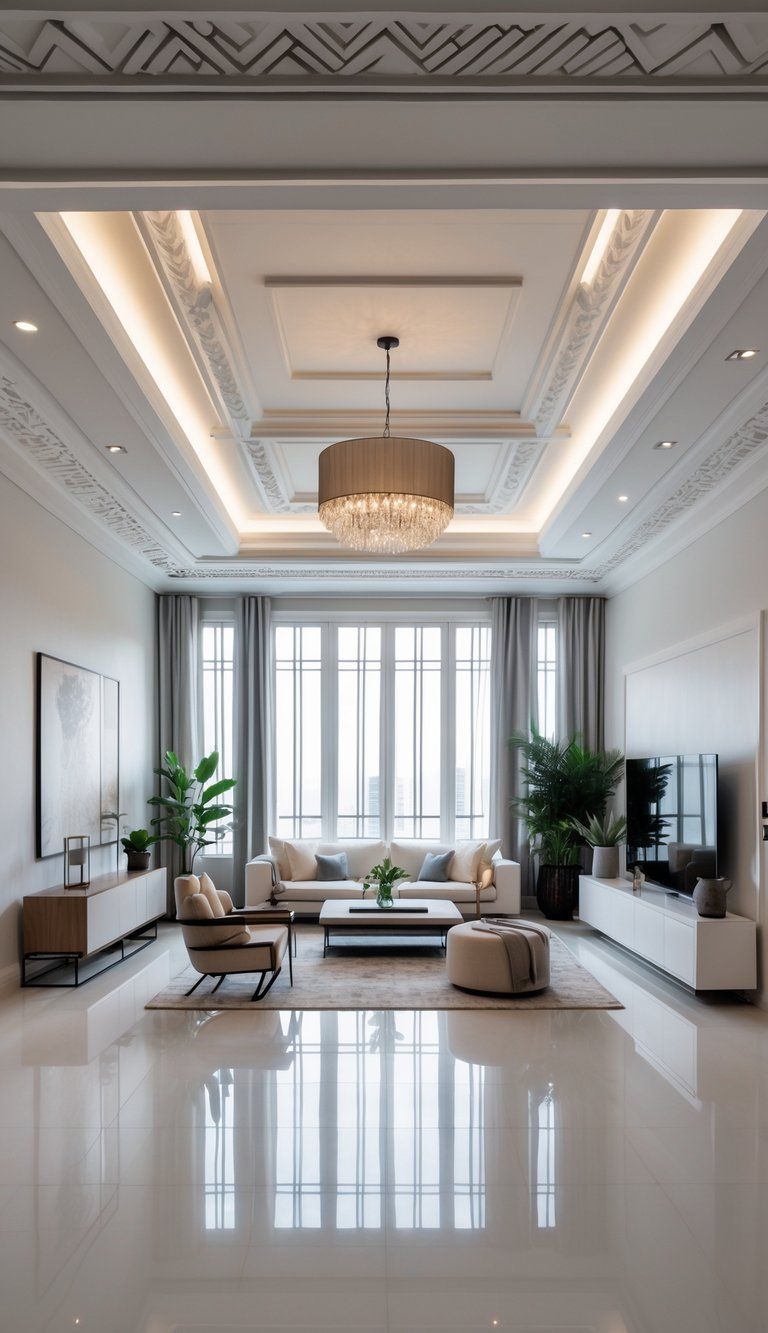
When you add a focal point to your ceiling, you can completely shift a room’s vibe. Dark ceilings feel cozy and intimate, while lighter ones open up a space. Smart lighting choices pull your gaze upward and show off the vertical dimension that most people ignore.
You’ve got a blank canvas overhead. Whether you’re into statement lights or bold paint, there are so many ways to make your ceiling pop. These designer-backed ideas don’t just look good—they actually change how you experience the whole room, making it feel bigger, more pulled together, or just flat-out dramatic.
Why Make Your Ceiling a Focal Point?
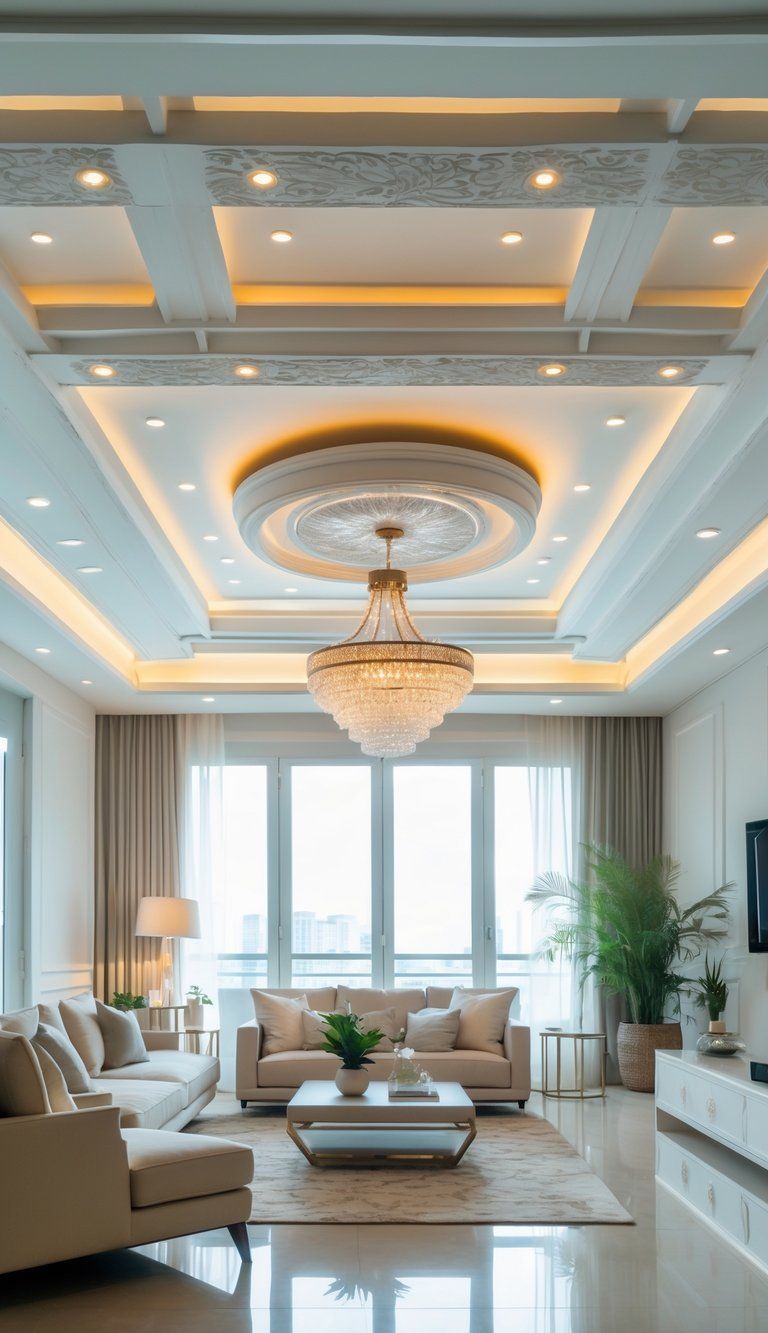
People call the ceiling the “fifth wall,” but honestly, most of us skip it when we’re making design plans. When you pull attention upward, you can turn a basic room into something really special by using all the space you’ve got.
The Impact of Statement Ceilings
A statement ceiling grabs attention right away. When someone walks into a room with a unique ceiling, their eyes go up, and suddenly the room feels bigger. It’s a great way to break up the monotony of plain white ceilings and show off your style.
You can use your ceiling to express your personality without taking up any floor space. Bold paint, architectural touches like beams or coffers, or even a decorative medallion can turn the ceiling into a conversation piece.
The best ceiling features work with your existing design, adding polish and a bit of wow that you just don’t get from a flat, plain ceiling.
Influence on Room Design and Ambiance
Ceiling treatments really set the mood. Go dark if you want a cozy, tucked-in vibe for a bedroom or dining room. If you want things to feel open, reflective finishes or light colors make a room feel bigger.
Add in details like coffers or exposed beams, and suddenly your room isn’t just a box—it’s got depth and texture. Shadows and highlights shift as the light changes, so the ceiling never looks exactly the same.
If you’ve got an open floor plan, a change in ceiling style can mark off different areas without putting up walls. Maybe you use a different paint or molding to show where the kitchen ends and the living room starts.
A well-designed ceiling brings everything together, making the whole room feel intentional, from the floor all the way up.
Choosing the Right Ceiling Style for Your Home

Your ceiling can totally change the whole feel of a room. The right design makes your ceiling stand out, not just fade into the background.
Evaluating Ceiling Height and Architecture
Start by figuring out how tall your ceilings are. If you’ve got standard 8-foot ceilings, stick with simple styles like recessed panels or shallow tray ceilings. Taller ceilings (anything over 9 feet) open up more options—think coffered designs or deeper trays.
Match the ceiling to your home’s style. Classic coffered or crown molding looks great in traditional spaces. If your place is more modern, you might want sleek lines or bold patterns.
Don’t forget about the bones of your house. Look for beams, ductwork, or anything that could get in the way—or maybe even use them as part of your design. Exposed beams can look amazing in farmhouse or industrial spaces.
Popular Ceiling Design Inspirations
Tray ceilings add depth without being too much. They’re great for dining rooms or bedrooms if you want a little extra elegance.
Vaulted ceilings make a room feel huge and full of light. Pair them with smart lighting and you’ll get a really open vibe.
Coffered ceilings bring classic charm and structure. They’re perfect for creating zones in open layouts.
Other fun ideas:
- Beadboard for a cozy cottage feel
- Wood planks if you want rustic warmth
- Decorative tiles for something different
- Painted designs if you’re on a budget but still want impact
Considering Room Function and Size
Think about what you actually do in the room. Kitchens need surfaces you can wipe down easily—like glossy paint or sealed wood. Living rooms can handle fancier ceilings that make people want to look up.
Keep it simple in small rooms. Light colors and minimal designs keep things from feeling tight. Sometimes just a medallion around a light fixture does the trick.
Bigger rooms can handle more drama. High vaulted ceilings or detailed coffers look amazing in big spaces.
Don’t forget lighting. Some ceiling styles are perfect for recessed lights or statement fixtures that add both function and flair.
Enhance With Paint: Color and Technique Strategies
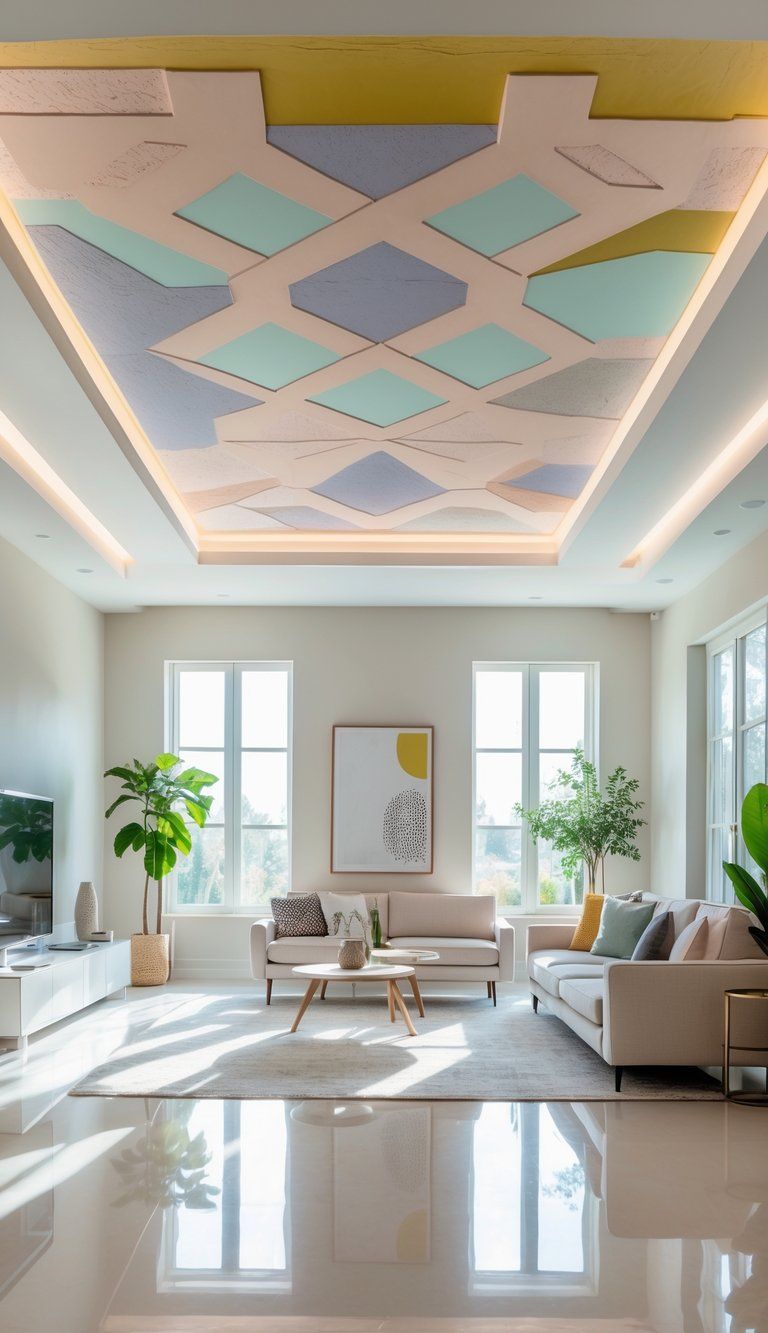
Paint can take your ceiling from invisible to incredible. The right color or painting technique changes the whole mood and lets your personality shine.
Bold and Dramatic Painted Ceilings
If you want drama, go dark. Deep navy, charcoal, or even black ceilings make a bold statement and can actually make a space feel bigger. This works best if you’ve got plenty of natural light.
Try painting your “fifth wall” in a dining room or bedroom for an unexpected twist. Pairing a dark ceiling with light walls creates a strong contrast that really catches the eye.
Black ceilings might sound risky, but they can look stunning—especially if you want to highlight your lighting fixtures or make a big room feel cozier.
Just make sure you use quality paint that bounces light around, so things don’t get too gloomy.
Creating Depth With Subtle Texture
Textured paint gives your ceiling more life without going overboard. Try layering glazes for a soft, cloud-like effect that changes with the light.
Venetian plaster and similar finishes add a touch of luxury through texture instead of just color.
If you’re feeling crafty, rag-rolling or color-washing with two similar shades adds interest without locking you into a big pattern.
These subtle textures are perfect for bedrooms and living rooms where you want a calm, soothing vibe. The light plays off the surface in a way that feels almost alive.
Geometric and Grid Patterns
Geometric patterns turn plain ceilings into a real feature. You can use paint and painter’s tape to make a grid or other shapes with just a little effort.
Some ideas:
- Checkerboard in two colors
- Herringbone for a classic look
- Circles or squares radiating out from a light
- Bold stripes to stretch the room visually
Measure carefully, press your tape down tight, and pull it off before the paint dries for crisp lines.
Grids and patterns work especially well in hallways, entryways, or bathrooms, giving those smaller spaces a polished, intentional feel.
Color Palette Selection for Ceilings
Pick a ceiling color that fits with the rest of your palette and the effect you want. Warm colors make high ceilings feel a bit lower and cozier.
If your ceilings are low, cool tones help them recede and make the space feel taller. Soft blues and greens create a fresh, open feeling.
A few tips:
- Try a ceiling color that’s a bit lighter than your walls for a subtle lift
- Use complementary colors for bold contrast
- Metallic paints bounce light and add a touch of glam
Always test your samples in the actual room, and check them at different times of day—light changes everything.
Your ceiling color influences how the rest of your colors look, so think about the whole room before you commit.
Elevating Your Ceiling With Wallpaper
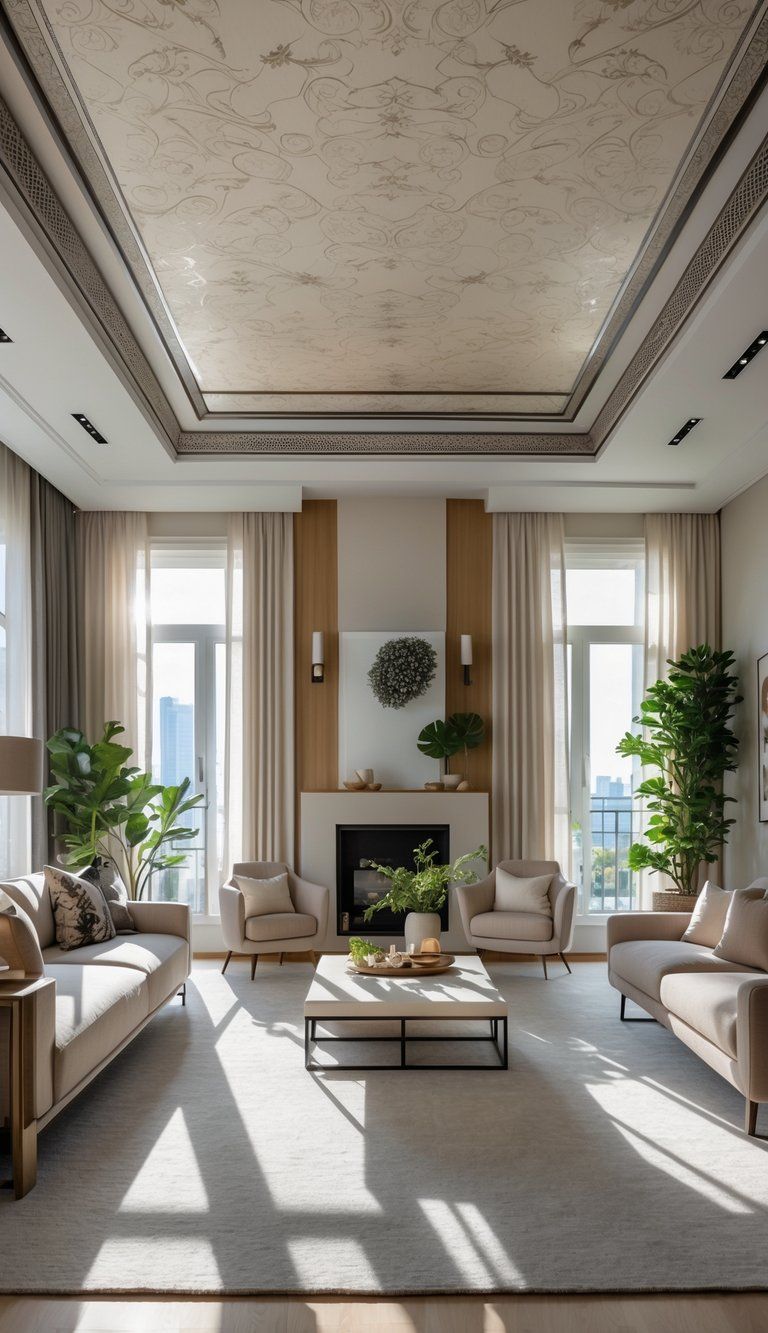
Wallpapering the ceiling can totally change a room, turning it into something unexpected and eye-catching. This trick has been around for centuries, but it’s definitely having a moment again—probably because it’s such a fun way to add color, pattern, and surprise.
Choosing the Best Patterns and Materials
Pick your wallpaper based on the room’s size and what you use it for. In small spaces, lighter colors and subtle patterns keep things feeling open but still interesting. If you’ve got a big room, you can go all-in with bold florals or geometric prints.
Materials matter too. Vinyl works best in kitchens and bathrooms since it handles moisture. For bedrooms or living rooms, textured papers like grasscloth add warmth and a little something extra.
Scale is key. Huge florals look great on high ceilings, but stick with smaller, repeating designs on standard-height ceilings.
Always test a sample first. Lighting really changes how wallpaper looks when it’s overhead.
Creating Visual Interest With Wallpaper
Designers love to call the ceiling the “fifth wall” because it’s a blank slate for creativity. Wallpaper up there can tie your whole room together by echoing colors from your furniture or adding a new accent.
Try wrapping wallpaper from the walls onto the ceiling in tiny rooms like powder baths for a cozy, wrapped-in feeling. In bigger rooms, just the ceiling is enough to make a statement.
If you want the ceiling to stand out, keep your walls simple. That way, patterns don’t fight for attention. If you use patterns on both, mix up the scale—big on the ceiling, small on the walls.
Lighting matters even more with a bold ceiling. Pick fixtures that work with your wallpaper, not against it.
Lighting Solutions That Highlight the Ceiling

Lighting can turn your ceiling into the main event instead of an afterthought. The right lighting choices not only brighten up your space, but also pull your eyes up to admire all that detail.
Chandeliers and Pendant Lights as Focal Points
A show-stopping chandelier instantly becomes the centerpiece in a high or vaulted ceiling. Make sure your fixture fits the space—go big in big rooms and don’t be afraid to make a statement.
Crystal chandeliers throw light around and add sparkle. For modern rooms, try geometric or simple pendant lights in a cluster for a cool effect.
Hang your chandelier 30-36 inches above a dining table. In living rooms with tall ceilings, you can go lower with a bigger fixture for a cozy feel that still shows off the height.
If you’ve got a two-story space, multi-tiered lights pull the eye up and fill the vertical space.
Integrating Recessed Lighting for Subtle Drama
Recessed lights give you a clean look and can highlight your ceiling without stealing the show. Place them so they wash the walls with light, adding depth and interest.
On vaulted ceilings, run recessed lights along the slope to accentuate the lines and keep things bright.
Dimmable LEDs tucked into beams or crown molding create a soft glow that brings out ceiling details.
Use recessed lights to spotlight features like medallions or molding. This creates cool shadows and highlights, giving even a flat ceiling more dimension.
Using Skylights and Natural Light
Skylights turn ceilings into ever-changing focal points that shift with the daylight. The sunlight they let in casts patterns that move as the sun crosses the sky.
If you want the biggest impact, place skylights where they’ll catch both morning and afternoon sun. Look for models with built-in shades so you can adjust the brightness and keep heat in check.
Tubular skylights make sense where traditional skylights just won’t fit. They funnel sunlight through reflective tubes and brighten up tight spaces.
Pair skylights with light-colored ceilings to bounce more light around. That sharp contrast between a dark skylight opening and a bright ceiling grabs attention.
In the evenings, try adding small accent lights around skylights. You’ll keep them as a focal point after dark, and the soft glow almost feels like daytime.
Architectural Features and Custom Details
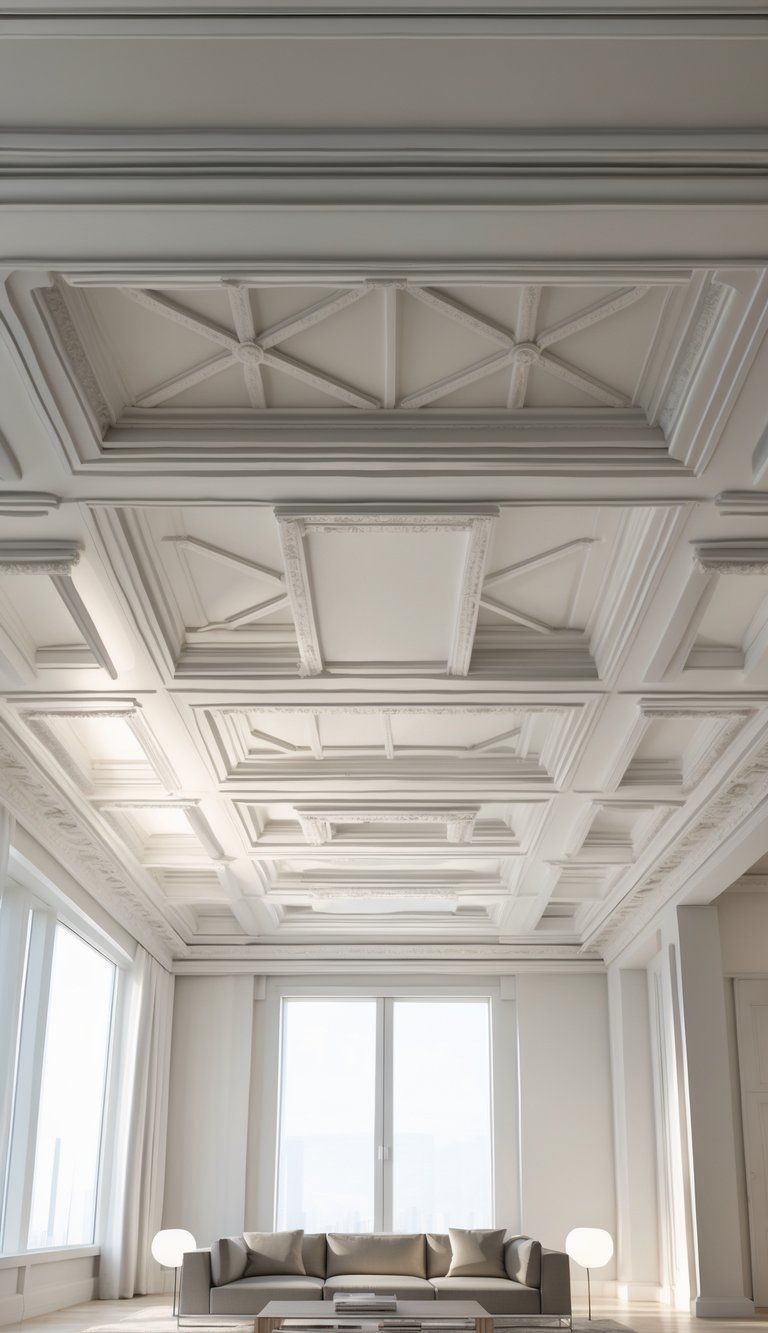
Add architectural elements to your ceiling and suddenly, the whole room has more character and depth. These custom touches turn into conversation starters and can even bump up your home’s value.
Decorative Beams: Wood, Painted, and Exposed
Wooden beams instantly add warmth and catch the eye overhead. Natural wood looks perfect in rustic or farmhouse spaces, but painted beams fit just about any style.
If you want everything to feel unified, match your beam color to your trim. Or, go bold and pick a contrasting color to make the beams pop.
High ceilings really benefit from exposed beams—they pull your gaze upward and add texture. Even in rooms with average ceilings, decorative beams can fake a sense of architectural depth.
You’ve got some choices for installation:
- Real structural beams (super authentic, but heavy)
- Hollow box beams (lighter, still look real)
- Faux foam beams (budget-friendly, easy to handle)
When it comes to arranging beams, try a grid pattern or follow your room’s natural lines for maximum effect.
Coffered and Tray Ceilings for Architectural Interest
Coffered ceilings use a grid of recessed panels to bring dimension and a touch of formality. They’re a classic choice for living rooms, dining rooms, or libraries.
Tray ceilings have a recessed center that creates depth with subtle layers. You can play this up by:
- Painting the recessed part a different color
- Adding LED strip lighting around the edge
- Using shiplap or beadboard inside the recess
For a modern vibe, go with a shiplap tray ceiling. White shiplap especially brightens up a room and adds a gentle pattern.
These ceiling treatments shine in spaces where you spend a lot of time. That way, you actually get to enjoy all the detail.
Incorporating Decorative and Crown Molding
Crown molding finishes off the space between your walls and ceiling, giving everything a polished feel. Choose the right size—wider molding for big rooms, thinner for small ones.
If you want to go beyond basic crown, try these:
- Medallions: Fancy circles around light fixtures
- Recessed panels: Framed sections that add depth
- Cove lighting: Hidden lights behind molding that wash the ceiling with a soft glow
For a custom look, stack different molding profiles together. This adds weight and makes your ceiling feel more significant.
Paint moldings in semi-gloss to show off the details and make cleaning easier. White is classic, but a little contrast can add dimension if you’re feeling adventurous.
Accents and Decor To Draw the Eye Up
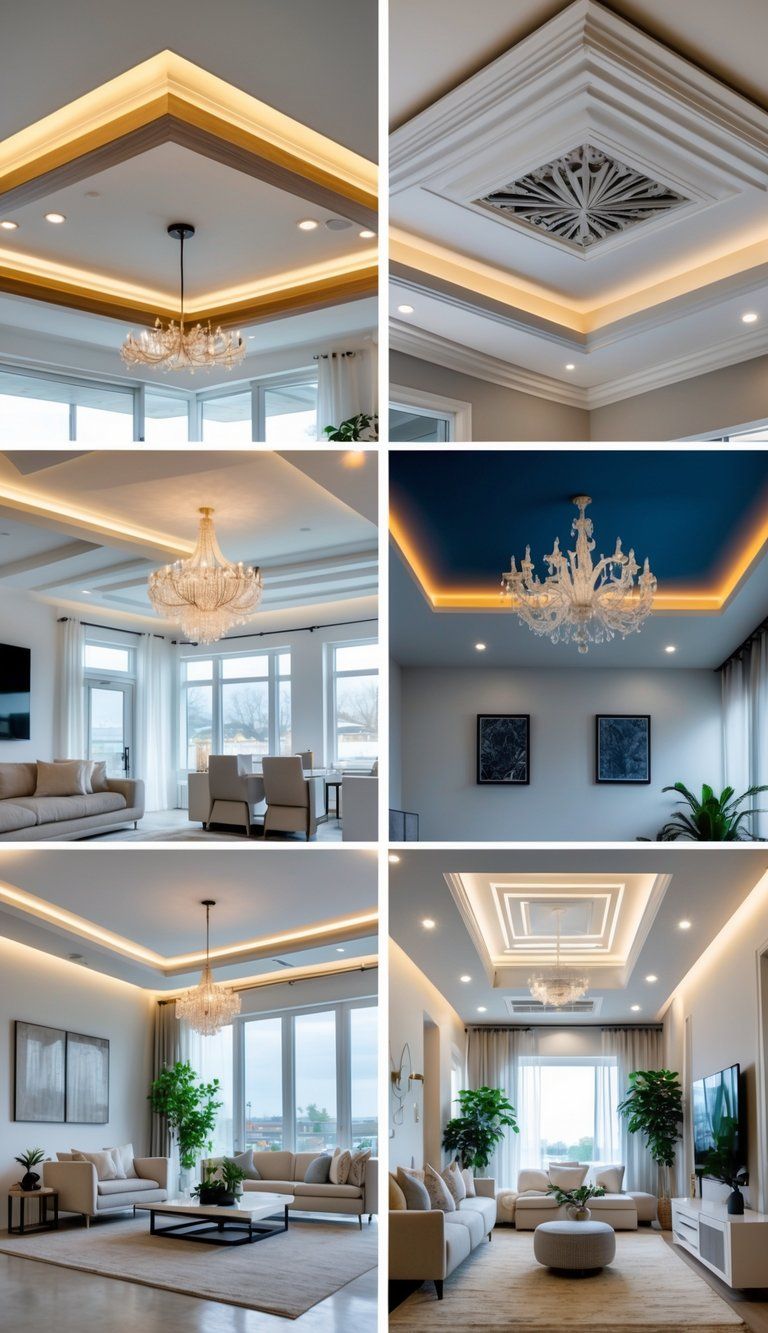
If you draw attention upward, ceilings stop being an afterthought and become a real design highlight. Placing decorative elements in the right spots adds vertical interest and makes the room feel larger.
Mirrors, Frames, and Art Installations
Mirrors high on the walls or even on the ceiling can totally change a space. They bounce light around and make the room feel taller. Try a cluster of small framed mirrors for a pattern, or go bold with a big mirror panel overhead.
Hang art high to guide the eye up. Some ideas:
- Vertical gallery walls reaching toward the ceiling
- Art suspended at different heights
- Framed prints with designs that flow upward
Designer tip: Put picture lights above your art. You’ll get a double effect—the art itself and a warm glow that leads your gaze to the ceiling.
Integrating Built-in Shelving and Bookshelves
Built-in shelves that stretch to the ceiling naturally pull attention upward and give you more storage. Paint them the same color as your walls for a seamless effect, or pick a contrasting color to make them stand out.
Tall bookshelves look especially good in rooms with vaulted ceilings. Try these:
- Floating shelves that step up toward the ceiling
- Library-style shelving with a sliding ladder for drama and function
- LED strips along the top shelf for a subtle upward glow
Even in small rooms, a single high shelf running around the perimeter adds an architectural touch that lifts the eye.
Plants and Other Ceiling Décor Elements
Plants bring life and vertical movement when you hang them from ceiling fixtures. Trailing types like pothos or string of pearls add texture and a bit of wildness overhead.
You don’t have to stop with plants. Try these ceiling décor ideas:
- Pendant lights at different heights
- Hanging mobiles for gentle movement
- Fabric panels or swags
- Floating paper lanterns for soft, diffused light
Material mix: Blend textures—wicker baskets, metal fixtures, glass accents—to keep things visually interesting up top.
Swap out ceiling décor with the seasons. Paper stars for winter, preserved flowers in spring—these little changes keep your ceiling features feeling fresh and intentional.
Creating Cohesive Room Design With Ceilings as Focal Points
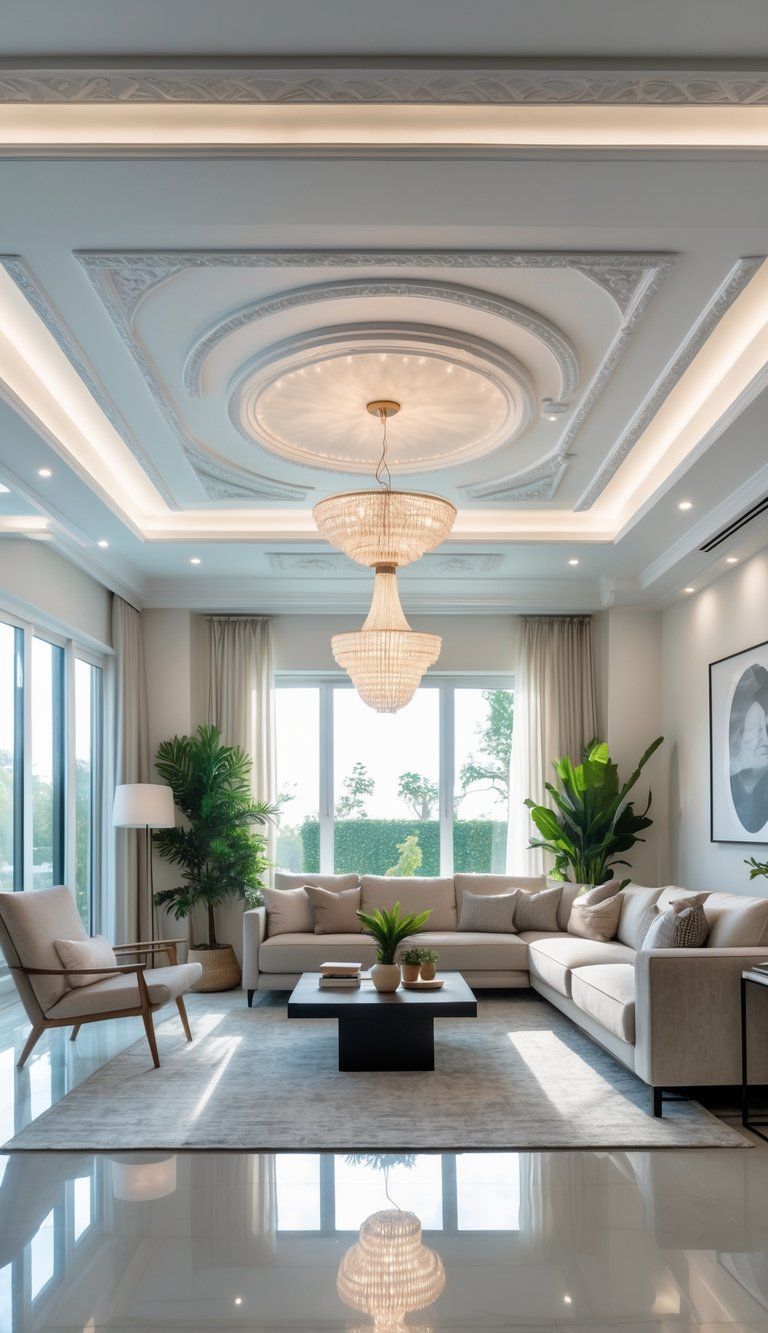
When you use your ceiling as a focal point, you want it to lift the room without taking over. The goal is to draw the eye upward and still keep everything in harmony.
Balancing Ceiling Features With Minimalist Design
Minimalist rooms actually work great with statement ceilings—they set up a nice contrast. Stick to low-profile, simple furniture if your ceiling is dramatic. That way, nothing competes for attention.
Pick just a couple of other decorative touches for the space. For example, if you’ve got a coffered ceiling with gold details, maybe echo that gold in a lamp or a vase.
Keep wall colors calm—neutral tones like soft white, light gray, or beige give your ceiling room to shine.
Some minimalist combos to try:
- Painted ceiling pattern + solid-colored furniture
- Wooden beam ceiling + sleek modern pieces
- Metallic ceiling + natural textures below
Coordinating Architectural Elements and Color Scheme
Let your ceiling design nod to the architectural features you already have at home. Got crown molding? Go for ceiling treatments that play nicely with those details, not ones that fight for attention.
Color coordination matters—a lot. Grab an accent color from your ceiling and sprinkle it around the room, but don’t overdo it. That little thread helps everything feel connected, even if it’s subtle.
Here are a few color tricks to try:
- Toss the ceiling color into throw pillows or hang up some art with similar shades.
- Look for wood furniture that picks up on the ceiling’s undertones.
- Bring in smaller decor pieces with textures that echo what’s overhead.
If you’re chasing a rustic vibe, match wooden beam ceilings with furniture or floors in similar wood tones. You’ll get a pulled-together look that doesn’t feel too forced.
Lighting fixtures can really tie things together. Pick ones that vibe with both your ceiling and the rest of your decor, and you’ll notice the difference.

